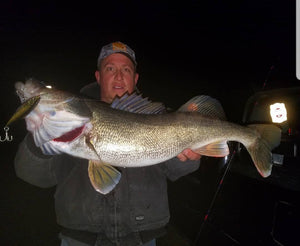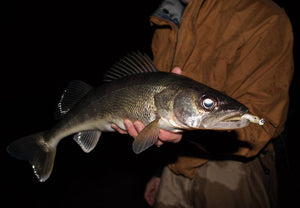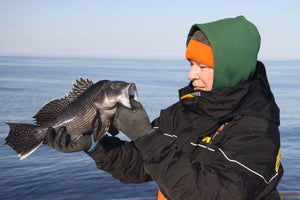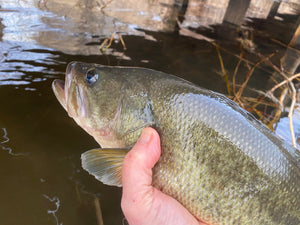Cracking the Inlet Code, Part II

Picking up our discussion of inlet fishing where we left off in Part 1, some inlets also feature a deep hole or two near their entrance and exits, and these often hold the biggest game fish throughout a tide. Big bass and weakfish seek out these holes and sulk down deep, often feeding only a foot or so off the bottom. Here, they’ll occasionally move about to gobble up a porgy, sea bass, small fluke or other bottom scavenger that’s probing the depths for an easy meal.
Tackle Counts
Yet another point to keep in mind when it comes to fishing inlets is that you’ll need some sturdy gear to handle the strong currents, water depths and big fish you’ll hopefully be dealing with on a regular basis.

If you are just getting started with inlet fishing, you’ll probably want to throw bucktails along the lines of an Andrus Jetty Caster weighing 2 – 4 ounces tipped with a Fat Cow Jig Strip or Fat Cow Split Tail Jig Strip for bass and ‘gator bluefish. Opt for a 2.75- to 4-ounce white or green Tube-Tail Diamond Jig if the bluefish are running thick, and consider tossing a Tsunami Deep Shad soft-plastic swimbait for the stripers if you spy some bunker or other large baitfish holding their own in a slowing current.
Of course, to handle the weight of these relatively heavy lures, as well as strong inlet currents, you’ll want a relatively stout surf rod most of the time. We suggest a 10- or 11-foot Lamiglas GSB Series Surf Rod. You can match this to a size 8000 Daiwa BG MQ or Shimano Saragosa SWA spinning reel. These reels are smooth, powerful, nearly indestructible, and feature significant drag ratings. Fill either with 30-pound test Power Pro braided line, tie on a three- to four-foot length of 30-pound-test Ande Premium Clear Leader Material, and add a Tactical Anglers Power Clip to the leader’s end for easy lure changing and you should be set to go.
Remember, with most of the lures you’ll throw in inlet waters, you’ll score best if you manage to keep them down in the water column. That requires both patience and the ability to sense exactly where your offerings are at any point in your retrieve. It does take some time to master inlet presentations, but with a little work and practice you’ll figure things out. If you need some advice on where to go, what to throw or putting together the perfect inlet fishing outfit, just stop by the shop. We’ll be glad to help.
One last thought on inlet tackle. While most anglers tend to concentrate their inlet efforts on bass, blues and fluke, it should be noted that our waters continue to warm over the past few years, the numbers of false albacore, along with more southern favorites like Spanish mackerel and bonito, have grown substantially. This adds a significant surface and mid-level inlet option for anglers during the heat of summer and early fall. It also allows anglers to use lighter gear in their inlet forays. Look for these fish to favor the first half of the inlet at the ocean end. Mostly, they’ll patrol open waters away from the jetty rocks and serious structure.
 OutdoorTom.com Photo
OutdoorTom.com Photo
If targeting the speed demons, consider scaling your outfit down to something along the lines of a 7-foot, 7-inch Tsunami Forged Surf Rod and a 4000 size Daiwa BG MQ reel so you’ll be able to toss smaller offerings and work the upper strata using Hogy Epoxy Jigs, size #1 Deadly Dicks, or plain single-hook diamond jigs on 20-pound test line with a 25-pound-test fluorocarbon leader.
Carry the above outfit along from early August through October to complement your heaver stick in case these quick and aggressive lighter-weight speedsters happen to arrive on the scene.
 Hogy Epoxy Jig - a deadly albie lure for casting in the inlets on lighter gear.
Hogy Epoxy Jig - a deadly albie lure for casting in the inlets on lighter gear.
Safety First
Having discussed the strong currents, rips and varied bottom configurations common to most inlets, it should come as no surprise that these are not areas where you can let down your guard. Be aware at all times that you need to hold a secure position while casting to, battling and landing fish of any size, from 2-pound harbor blues to potential 40-pound stripers. If you plan to fish from jetty rocks, be sure to wear Korkers Cleated Fishing Overshoes to help secure your footing.
If you’re a true novice making your first few attempts at jetty fishing, it’s best to head out with a fellow angler who has some experience at this game. That way, you’ll have someone nearby to show you the ropes, help you identify the risks, and confirm your tide choice seems like a good idea. In general, it’s also smart to limit your first few adventures to daylight hours so you can familiarize yourself with the inlet/jetty routine before considering taking this route after dark.
- Bryce Poyer






